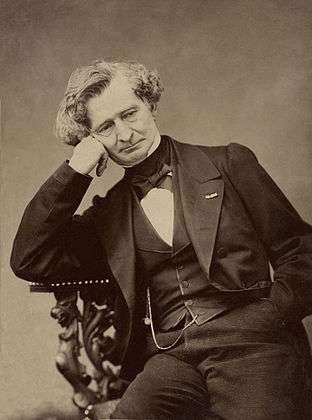Grande symphonie funèbre et triomphale
Grande symphonie funèbre et triomphale (English: Grand Funeral and Triumphal Symphony), Op. 15, is the fourth and last symphony by the French composer Hector Berlioz, first performed on 28 July 1840 in Paris. This symphony is one of the earliest examples of a symphony composed for wind band.
Introduction
The French government commissioned the symphony for the celebrations marking the tenth anniversary of the July Revolution which had brought Louis-Philippe to power, for which it was erecting the July Column in the Place de la Bastille. Berlioz had little sympathy for the régime, but welcomed the opportunity to write the work because the government had offered him 10,000 francs for it. The Symphonie militaire (later renamed Symphonie funèbre et triomphale), rather than following the model Berlioz had established in Romeo and Juliet represents a reversion to an earlier pre-Beethovenian style in the tradition of monumental French public ceremonial music.[1] Berlioz claimed to have completed the entire score in just 40 hours,[2] harvesting much of the musical material for this Grande symphonie funèbre et triomphale from unfinished works. The first movement, the "Marche funèbre", was constructed from the Fête musicale funèbre à la mémoire des hommes illustres de la France, a massive, seven-movement ceremonial piece begun in 1835 in the hopes of selling it to the French government. According to Julian Rushton, "Berlioz worked best on large projects; when he could see no future for them he preferred not to compose.”"[3] He apparently abandoned the Fête musicale funèbre because he couldn't find a sponsor to commission it.
The Funeral and Triumphal Symphony was originally scored for a wind band of 200 players marching the procession accompanying the remains of those who had died fighting in the 1830 revolution on their way to reinterment beneath a memorial column erected on the site of the Bastille. On the day of the parade, little of the 3rd movement could be heard over the cheering crowds on the column when the ceremony was about to end as it was about to be reprised while the 1st and 3rd movements were heard during the procession and the 2nd during the dedication proper; but the work was such a success at the dress rehearsal that it was performed twice more in August and became one of the composer's most popular works during his lifetime.[4] Berlioz revised the score in January 1842, adding an optional part for strings and a final chorus to a text by Antony Deschamps. Richard Wagner attended a performance of this new version at the Salle Vivienne on 1 February 1842. On 5 February, he told Robert Schumann that he found passages in the last movement of Berlioz's symphony so "magnificent and sublime that they can never be surpassed."[5]
Composition of the symphony
The symphony is in three movements.
- Marche funèbre (Funeral march). A slow, mournful march in F minor.
- Oraison funèbre (Funeral oration) Berlioz reused an aria from Act III of his abandoned opera Les francs-juges, replacing the voice part with a trombone.
- Apothéose (Apotheosis) A brilliant triumphal march in B-flat major, with an optional choral finale.
Lyrics
Berlioz commissioned Antony Deschamps in 1842 to provide lyrics to be sung by choirs at the end of the final (Apothéose) movement of the symphony.
French (public performance lyrics)
Gloire!
Gloire! Gloire et triomphe!
Gloire!
Gloire et triomphe, à ces Héros!
Gloire!
Gloire et triomphe!
Venez, élus de l’autre vie!
Changez, nobles guerriers, tous vos lauriers,
Pour des palmes immortelles!
Suivez les Séraphins, soldats divins,
Dans les plaines éternelles!
A leurs chœurs infinis, soyez unis!
Anges radieux, harmonieux, brûlants comme eux,
Entrez, sublimes victimes!
Gloire et triomphe, à ces Héros!
Ils sont tombés aux champs de la Patrie!
Gloire et respect à leurs tombeaux!
Venez, élus de l’autre vie!
Gloire!
Gloire et triomphe, à ces Héros!
Gloire!
Et Respect!
A Leurs!
Tombeaux!
Instrumentation
Berlioz scored the symphony for a large military band or concert band, with optional choir and string instruments. The following list reflects both the number of instrumental parts and the number of musicians Berlioz intended for each instrument:
- piccolos (4 players), flutes (5 players), oboes (5 players), E-flat clarinets (5 players), 2 B-flat clarinets (26 players total), bass clarinets (2 players), bassoons (8 players), contrabassoon (ad lib)
- 6 horns in F, A-flat, E-flat, G, D and C (12 players total), 4 trumpets in F, C and B-flat (8 players total), 2 cornets in A-flat, G and B-flat (4 players total), 3 trombones (3 tenors or alto and 2 tenors, 10 players total), bass trombone (ad lib), 2 ophicleides (6 players total)
- 2 snare drums (8 players total), timpani (ad lib), cymbals (3 players), bass drums, tam tam, turkish crescents
- choir and strings (both ad lib)
In addition to the three trombones, a solo tenor trombone appears in the second movement. The choir, if used, only appears in the final movement. The strings, if used, only appear in their entirety in the final movement, with the cellos and basses also appearing in the first movement.
Recordings
- Berlioz: Requiem & Grande symphonie funèbre et triomphale: John Alldis Choir, London Symphony Orchestra, conducted by Sir Colin Davis (Philips)
Sources
- ↑ Cairns, David (1999). Berlioz: Volume 2, Servitude and Greatness. Berkeley and Los Angeles, CA: University of California Press. p. 209. ISBN 0-520-22199-0.
- ↑ Newman, Ernest (1935). Memoirs of Hector Berlioz. New York: Tudor. p. 170.
- ↑ Rushton, Julian (1983). The Musical Language of Berlioz. Cambridge: Cambridge University Press. p. 12.
- ↑ Cairns, David (1999). Berlioz: Volume 2, Servitude and Greatness. Berkeley and Los Angeles: University of California Press. pp. 208–210. ISBN 0-520-22199-0.
- ↑ Bloom, Peter (1998). The Life of Berlioz. Cambridge: Cambridge University Press. p. 97.
- David Cairns, Berlioz: Servitude and Greatness Volume 2 (Viking, 1999)
- Hugh Macdonald, Berlioz ("The Master Musicians", J.M. Dent, 1982)
- Hector Berlioz, Memoirs (Dover, 1960)
